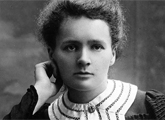Precursor in the field of radioactivity, first woman to be awarded the Nobel Prize and first person to achieve this twice in two distinct categories: physics in 1903 and chemistry in 1911, María Salomea Sklodowska, better known as Marie Curie, is honored in Montevideo 150 years after her birth.
“Marie was an extraordinary person, with a generation-spanning importance, and a model of lived engagement with society”, notes Walter Kruk, vice president of the Polish Society in Uruguay.
A life of struggle
Marie Curie was born in Poland on the 7th November 1867 - during the Russian occupation - as a French citizen. She studied clandestinely in a “floating university” in Warsaw, and moved to Paris in 1981, at the age of 24, where she continued her studies in physics, chemistry and maths.
In 1984, she made acquaintance with whom later should become her husband, the French physician Pierre Curie. Their mutual interest for science united them and they did not separate until Pierre’s death in 1906 following an accident.
Madame Curie concluded her doctoral thesis in 1896 on the recent works of Henri Becquerel, who had discovered that uranium salts produce unknown rays. Together with her husband Pierre, the scientist started investigating the causes of this phenomenon. Her first great discovery in relation to this investigation was that the radiation resulted from the nature of the material itself.
In 1903, she defended her dissertation which earned her the first Nobel Prize for Physics, together with her husband and Henri Becquerel. At first, the Committee intended to award the prize only to her husband and Henri Becquerel. Pierre, however, made clear that he wouldn’t accept the prize, if his wife was not honored.
During their investigation, the couple discovered the existence of two elements still unknown by then: polonium (named after its country of discovery), and radium. This earned Marie Curie her second Nobel Prize, this time for Chemistry.
In 1906, she occupied the chair of Physics in the University of Paris, a position that had been vacant after her husband’s death, and became the first female lecturer in this institution.
Madame Curie passed away on 4th July 1934, at the age of 66, due to aplastic anemia caused by the high radiation she was exposed to in the course of her life.
Revolutionary woman
Last Wednesday and one and a half centuries after her birth, the Polish scientist was honored with flower offerings on the square named after her. The act counted on the presence of the French Embassy, the Polish Society Mcal. José Pilsudski and the Mayor of Montevideo, Daniel Martínez.
“She was an example for the fight against gender limits”, said Kruk.
The mayor felt “very honoured” for participating in the tribute and highlighted “Madame Curie’s fight for women and the equality of opportunities” in a time when being recognized and accepted in the scientific field was difficult for a woman. Martinez called her “an icon of the progressive woman”.
For his part, the vice president of the Polish Society, Walter Kruk, also stressed this aspect and said that Marie Curie has been an impulse for physics and chemistry, and noted that throughout her life two “outstanding characteristics” prevailed. The first one is that she lived in times when women were not allowed neither in the scientific field, nor on university chairs, and, nevertheless, achieved both. “She was an example for the fight against gender limits”, said Kruk.
Marie Curie is an example for Polish people who helped others and their sons born outside Poland to bear the scars inflicted on a country invaded during the Second World War.
In fact, during the First World War, Curie invented the first mobile machine for radiography, so that X-Rays could be taken to various hospital centers and save the lives of hundreds of soldiers.
More tributes
Apart from the act carried out on Madame Curie Square, a tribute will take place in Sala Nelly Goitiño in the Sodre on Wednesday, the 8th, in the presence of the President of the Republic, Tabaré Vázquez. In the Foyer of the auditorium the exhibition “Maria del Mundo” will be inaugurated. The exhibition belongs to the Warsaw-based Museum Maria Sklodowska-Curie and will stay open until the end of November.
Source: www.cromo.com.uy
